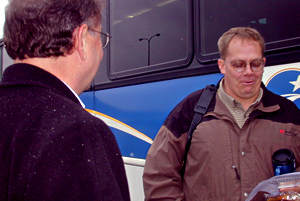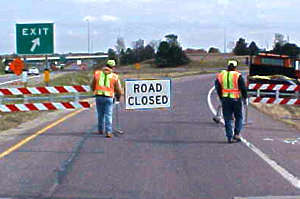 |
 |
|
 |
Popular Northstar Commuter Coach service tops ridership forecast |
 |
 |
 |
Mn/DOT acting Commissioner Doug Weiszhaar (left) queries a North Star
Commuter Coach passenger about his experiences. Photo by Sue Stein
|
At the end of its first year of operation, Mn/DOTís Northstar Commuter Coach
service between Elk River and downtown Minneapolis exceeded initial ridership
projections according to Transit Director Donna Allan, who called it a model
for future commuter service development.
Ridership grew to about 50 percent of capacity within its first few months
of operation, Allan said. Since Labor Day, use has increased to 60 percent of
capacity. The new service carries about 550 passengers each day along the 30-mile
route in the Hwy 10 corridor, which is the regionís most heavily traveled commuter
route.
Eight buses run during the morning and afternoon peak hours Monday through
Friday. The buses offer reclining seats, reading lights, plug-ins for laptop
computers and other amenities. A survey conducted in May 2002 showed that 94
percent of riders were satisfied with the service. Twenty-seven percent of the
passengers formerly drove alone, the survey revealed.
The Northstar Commuter Coach was created as a demonstration project to show
the publicís willingness to use transportation options. It is the first such
service operated by Mn/DOT.
"Customers have told us that they want, safe, time-predictable trips and
this service offers just that," said Doug Weiszhaar, acting commissioner.
"It also demonstrates that there is a demand for transportation choicesóif
you offer options, people will use them."
Funding for the project will end in September 2003 unless the Legislature appropriates
more funds to continue the service.
For more information, visit the North Star Web site at www.commutercoach.org.
By Sue Stein
|
back

|
 |
Maintenance announces relocation of Central Servicesí functions |
 |
 |
The Office of Maintenanceís Central Services functions will move from the Fort
Snelling facility to new locations by January 2004.
On Oct. 22, the Senior Management Team determined the Central Services core
functions will move to the following locations:
-
Fleet Maintenance
The fleet maintenance function will relocate to an existing Metro Division
site.
-
Snowplow Fabrication
The snowplow fabrication function will relocate to the Mn/DOT district maintenance
facility in Bemidji. The newly built facility provides the unit with the
necessary space for a successful snowplow fabrication operation.
-
Fleet Management
Fleet management, which comprises fleet administrative services and
fleet purchasing, will be located in the Metro area, possibly in the Central
Office.
-
Electrical Services Section
Both Metro and centralized ESS functions will relocate to a new joint Metro/City
of North St. Paul facility. Mn/DOT will lease space until the facility is
available.
"We looked at several options, from using existing Mn/DOT and Greater
Minnesota facilities to partnering with local groups to build a new facility,
but our first priority was to provide sites that would allow employees to perform
their duties in a safe and timely manner," said Mark Wikelius, state maintenance
engineer.
The Office of Maintenance is working with the Office of Human Resources and
the unions to determine the best way to accommodate employees during this transition.
For more information
about the relocation of Central Services, visit their Web site. The site
will be updated as additional information becomes available.
By Daneeka Marshall-Oquendo
|
back

|
 |
SMT okays Corporate Business Group organizational development plan |
 |
 |
Expect to see a few changes in the Corporate Business Group in future months
as the group develops a plan for expanding and improving the financial information
and services it provides.
Kevin Gray, group director and Mn/DOTís chief financial officer, presented
his vision for the new financial organization to the Senior Management Team,
which approved the recommendations Oct. 1.
"I want to ensure the Corporate Business Group is positioned from a resource
and organization perspective to meet the future challenges and expectations
of the groupís customers and stakeholders," Gray said.
The recommendations include:
-
Incorporating the activities of business planning and activity-based budgeting
into the permanent organizational structure
-
Improving the groupís ability to provide financial information, better
forecast economic needs and improve customer responsiveness
-
Improving staff use and better aligning human and fiscal resources with
the groupís strategic plan
-
Ensuring consistency with the departmentís strategic concept of the distributed
product/service model articulated in Shaping Our Future
An implementation team will develop specific plans for the organizational changes
during the next couple of months, with implementation expected to begin in January
2003.
Organizational study
The recommendations are based on the results of an organizational study of
the Corporate Business Group conducted in July. The project teamóincluding staff
from the Corporate Business Group, Human Resources and Management Operations
Group Administrationóexamined the current work of the group and interviewed
several of its key customers and stakeholders. In addition, the team reviewed
the organizational design and scope of six other state departments of transportation
and compared them to Mn/DOTís.
Contacting other transportation departments confirmed that there is no consistency
in organizational structures from state to state, said Eric Davis, Human Resources.
Interviews with customers and stakeholders provided useful information for
the project team, he added. Customers reported a general satisfaction with the
current daily interaction and service they receive from group employees, but
indicated a preference to permanently align business planning activities and
budgeting activities, and expressed a recurring need for consistent, reliable
and just-in-time financial reports.
In addition to meeting with SMT, Gray presented the organizational study results
and development plan to the Administrative Resource Team on Oct. 23. He also
met with Corporate Business Group managers and supervisors in mid-October to
review the study results, clarify the vision of the new organization and seek
feedback on the proposed changes.
The Corporate Business Group currently is composed of two officesóFinancial
Management and Financial Planning and Analysisóthat together employ about 70
employees, all of whom are located in Mn/DOTís Central Office.
By Chris Joyce
|
back

|
 |
Sales tax-related purchasing freeze remains in effect |
 |
 |
A departmentwide freeze on purchases on which Mn/DOT must pay the state sales
tax remains in effect.
The freeze results from conflicting state laws concerning Mn/DOTís payment
of the state sales tax. One statute requires sales tax payment by state agencies;
another stipulates that monies from the Trunk Highway Fund cannot be used to
pay the state sales tax.
The Legislature had provided a special fund that allowed Mn/DOT to use it instead
of Trunk Highway Fund cash to pay the sales tax. Those funds, however, have
been spent.
Typically, Mn/DOT pays sales tax on purchases such as computers, office supplies,
furniture and janitorial supplies.
Jim Kinzie, Financial Management, notes that significant progress has been
made to resolve the issue and that a solution is near to resolve the current
freeze.
"Until that time," Kinzie said, "we would appreciate your continued
effort in operating within the guidelines of the freeze."
By Craig Wilkins
|
back

|
 |
Gates divert freeway-bound traffic during severe weather |
 |
 |
 |
Darren Wencl and Roger Moreland, Owatonna, install a gate on an entrance
to I-35 to restrict freeway access during severe storms that often strand
motorists. Photo by Larry Kruckeberg
|
Bad weather has often stranded motorists and passengers on Minnesotaís highways,
as their Mn/DOT and State Patrol rescuers can attest. The need for this service
in southeastern Minnesota could decrease considerably, however, now that Rochester/District
6 plans to install eight gates on southbound entrance ramps to I-35 in Steele
and Freeborn counties.
The new snow gates will help keep traffic from entering the freeway during
winter storms or other severe weather conditions. The gates are manually operated
and are similar to other snow gates used on I-94 and I-90.
"Heavy snow, icy surfaces or whiteout conditions force us to close southbound
I-35 south of Owatonna every year," said Wes Smith, Owatonna maintenance
area superintendent. "In the past, we had to pay to have local police and
fire departments keep the ramps closed while our crews cleared the freeway.
Now a closed gate can serve the same purpose."
Smith said staffing a ramp for one six-hour closure last year cost $5,600.
The price for all eight new gates was $2,500.
Stranded vehicles create safety hazards and delay opening roads to traffic.
These delays also increase costs for shippers and consumers. If the stranded
vehicles are not blocking travel lanes, then Mn/DOT and the State Patrol will
leave unoccupied vehicles alone until weather and traffic return to normal.
|
back

|
 |
Governor to meet Mn/DOT employees in Central Office Oct. 31 |
 |
 |
Gov. Jesse Ventura will speak briefly with Mn/DOT employees from the Metro
Division and the Central Office at 9:30 a.m. on Oct. 31 in the Transportation
Building cafeteria. Doug Weiszhaar, acting commissioner, will also speak.
All employees from the Central Office, other Capitol complex offices and the
Metro Division are invited to attend. Participants should arrive in the cafeteria
by 9:20 a.m.
Refreshments will be served.
Videotaped copies of comments by the governor and the commissioner will be
available through the Mn/DOT Library beginning Nov. 1.
|
back

|
 |
Morey named Surveying and Mapping director |
 |
 |
 |
|
Rick Morey is now the director of the Office of Land Managementís Surveying
and Mapping Section. Photo by Denny Brott
|
Rick Morey was appointed as director of the Office of Land Managementís Surveying and Mapping Section. Morey succeeds Dave Gorg, who retired. Before his appointment,
Morey served as a principal land surveyor with the Metro Division at Golden
Valley.
In his new role, Morey will manage the Geodetic, Geographic and Mapping, Survey
Research and Support, Land Information Services, Legal Descriptions and Platting,
Land Information and Right of Way and Mapping units.
A native of Minneapolis, Morey holds a degree in philosophy from the University
of Minnesota and has completed coursework in surveying at Inver Hills Community
College. He is currently pursuing a masterís degree in geographic information
systems at the University of Minnesota.
Morey may be reached at 651/296-5710.
|
back

|
 |
Budget constraints require canceling 2003 Transportation Conference |
 |
 |
Due to budget shortfalls, Mn/DOT will cancel the 2003 Transportation Conference
scheduled for February. The decision stems from Mn/DOTís ongoing efforts to
find ways to reduce costs and use its resources most effectively.
Another factor affecting the decision is Mn/DOTís hosting of the 2003 national
conference for the American Association of State Highway and Transportation
Officials in the Twin Cities next September. The AASHTO conference will require
extensive Mn/DOT participation in planning, coordination and execution.
"On one hand, we are constantly looking for ways to use our people and
resources more wisely," said Doug Weiszhaar, acting commissioner. "On
the other, next year in September we will be actively involved in a large, national
transportation conference that will require a substantial commitment of people
and resources.
"After analysis, it became clear that it would not be a good business
decision to conduct both events, especially during a period when we are looking
for ways to do more with less," he added. "The AASHTO conference is
a tremendous opportunity to showcase Mn/DOT and Minnesota and it clearly is
a priority event."
The AASHTO meeting will attract transportation professionals and leaders from
across the United States. Mn/DOT will evaluate the possibility of holding a
transportation conference in 2004 later next year.
By Gary Pettis
|
back

|
 |
|
 |



